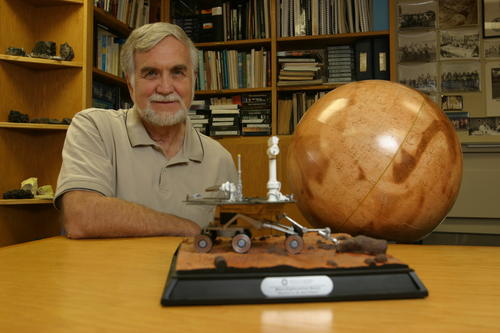Ronald Greeley - An early HRSC team member
Ronald Greeley’s passion was Mars science. Not only was he a co-investigator for the Mars Express HRSC, but he was also involved in other Mars missions, such as Mariner, Viking, Pathfinder, Mars Global Surveyor and the Mars Exploration Rovers Spirit and Opportunity. His career in planetary research began in 1967 at NASA AMES Research Center, where he studied volcanic landforms and lava tubes on Earth and the Moon. He later worked with planetary mission data acquired by Galileo for Jupiter, Magellan for Venus, and Voyager 2 for Uranus and Neptune. He was also interested in surface features and processes that occur due to the effects of wind on other planets. In 1977 he became Professor of the School of Earth and Space Exploration at Arizona State University, where he created the Planetary Aeolian Laboratory, which is still running to this day. Atmospheric processes on planets were researched in closer detail here using a wind tunnel and a device that could generate vortex motion.
Ronald Greeley passed away on 27 October 2011 as an internationally renowned and distinguished scientist. In 2015 the International Astronomical Union (IAU) named this Martian crater in his honour. Further, the Ronald Greeley Center Center for Planetary Studies (RGCPS), at Arizona State University, Tempe, is one in a network of 16 Regional Planetary Image Facility (RPIF) data centers, established by NASA to archive planetary images for use by the scientific and educational communities. The RGCPS began as the Space Photography Laboratory (SPL), established by Dr. Ronald Greeley when he moved from the NASA-Ames Research Center to Arizona State University in 1977. Prof. Ronald Greeley was the Director of the SPL until he passed away in 2011. Prof. David A. Williams is the current director of the facility, which has since been renamed the Ronald Greeley Center for Planetary Studies.
“Ron Greeley’s colleagues at Arizona State University are so honored with this HRSC product of Greeley Crater on Mars,” said Dr. David Williams, Associate Research Professor in ASU’s School of Earth and Space Exploration and an HRSC Co-Investigator. “We even have a rendition of this HRSC mosaic of Greeley Crater in our newly-renovated Ronald Greeley Center for Planetary Studies, the NASA Regional Planetary Information Facility at ASU”.
